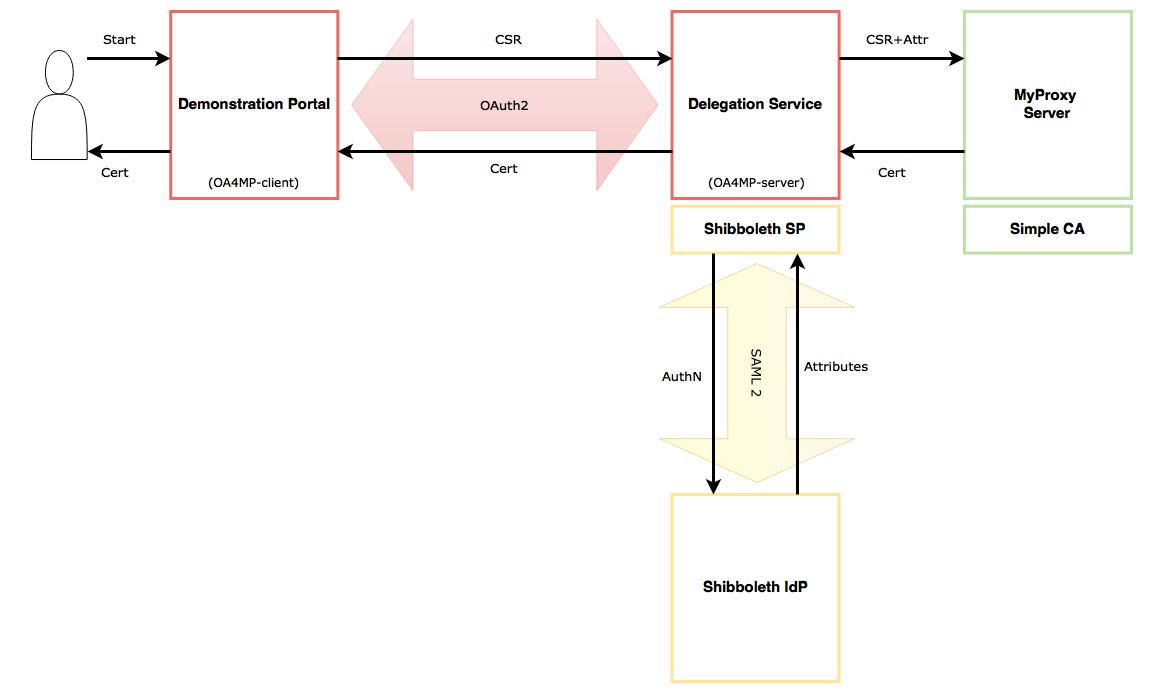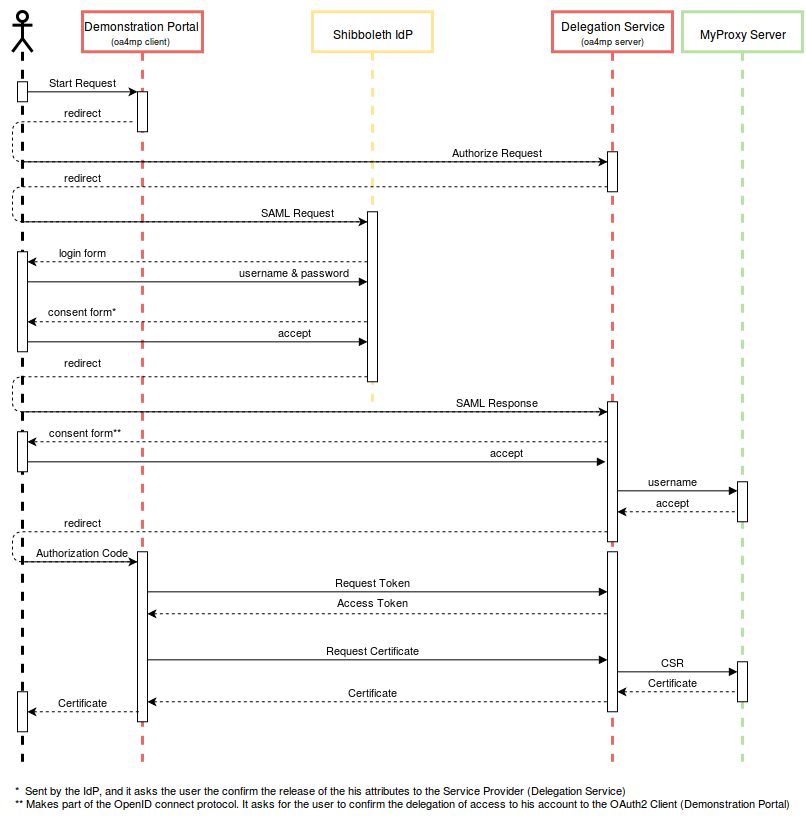Difference between revisions of "CILogon Pre-Pilot Work"
(→Architecture: Update diagram plus corresponding text) |
(public demo) |
||
| Line 121: | Line 121: | ||
8) This can then be used by the user to authenticate using PAM against the '''MyProxy Credential Store''' to retrieve a short-lived proxy. In this case, it is probably necessary to do the vomsification on client side. | 8) This can then be used by the user to authenticate using PAM against the '''MyProxy Credential Store''' to retrieve a short-lived proxy. In this case, it is probably necessary to do the vomsification on client side. | ||
| + | |||
| + | === Public Demo === | ||
| + | |||
| + | There is a public instance of the setup described above living in [https://okeanos.grnet.gr/home/ Okeanos]. You can start the flow of receiving a voms proxy by navigating to the [https://snf-676786.vm.okeanos.grnet.gr/vo-portal/ VO Portal]. The public demo works with the [https://wiki.surfnet.nl/display/surfconextdev/Connecting+to+SURFconext+test+environment SURFconext Test Instance] to showcase the integration with an identity federation. You will have to log in with one of the test professor accounts. Please note, that this setup is still under development, therefore it is subject to frequent changes. | ||
Revision as of 14:12, 3 November 2015
Introduction
AARC is a European research and collaboration project which explores the possible future generation of authentication and authorization methods used in the grid world. CILogon is a candidate AAI component within this project. This document is the starting point of a piloting work on CILogon which will eventually evolve into a larger scale demonstration of the capabilities of this software product.
CILogon is an open source project used to provide x509 certificates based on the authenticated user's federated identity. These x509 certificates are then meant to be used as authentication in further interactions with grid services.
We used Jenkins together with OpenStack to build an automatically deploying demo instance. Jenkins VM Image templates are used to boot VMs with relevant software installed on it, while separate Jenkins jobs are used to carry out different stages of the service deployment. You can find more details at CILogon Pre-Pilot Work - Jenkins and github.
Use Cases
Demonstration Portal
We aimed our first use case at setting up a Demonstration Portal through which authenticated users can retrieve x509 certificates. This setup mimics the CILogon Portal Demonstration.
The user goes to the Demonstration Portal and starts the flow by asking for a certificate. The Demonstration Portal creates a new private key and a certificate signing request (CSR). The private key is kept in the Portal, while CSR is eventually sent to the Delegation Service (acting as an online CA). At the Delegation Service the user gets redirected to his home IdP for authentication (for now there is only one single IdP in our setup). After authentication and consent the user attributes are sent to the Delegation Service. The Delegation Service uses MyProxy-Server (CA) to create a user certificate from the CSR and user attributes. This certificate is then sent back to the user.
Components
CILogon is based on OAuth for MyProxy (OA4MP). For the purpose of this Demonstration Portal we used OA4MP because it's much better documented then setting up CILogon itself, and because it was the recommended way to go by Jim Basney (CILogon).
- OA4MP : using both the client and the server components from the latest OAuth 2.0 implementation (3.1.1)
- Shibboleth : using the latest Identity Provider (3.0), and Service Provider (2.0)
- MyProxy Server : using official releases from epel (6.1.13)
- SimpleCA : using official release from epel (4.20)
Architecture
- Demonstration Portal
- - The Portal runs as the oa4mp-client (oauth2 client) in this setup. The protected resource in this case is the user certificate that will end up in the Portal at the end of the oauth2 flow. This Portal is then used to access a protected resource with the user certificate as suggested by [1] (this is not part of our demo setup just yet).
- - The oa4mp-client has to be registered with the corresponding oa4mp-server before it can be used. This is usually done through the /register endpoint of oa4mp-server.
- Delegation Service / SP
- - The Delegation Service runs as the oa4mp-server (oauth2 server) and provides a frontend to the MyProxy CA. The oauth2 protocol implementation follows the specifications outlined at OpenID Connect for MyProxy.
- - The oa4mp-server runs behind an httpd reverse proxy configured with mod_shib, which redirects requests to Shibboleth IdP for user authentication.
- Shibboleth IdP
- - This is a simple Shibboleth IdP setup backed up by an LDAP server. It releases user attributed to the Shibboleth SP running in front of the Delegation Service.
- MyProxy Server / SimpleCA
- - MyProxy Server is configured to run as Certificate Authority (CA). It creates user certificates from the CSR and user attributes. The user attributes are used to fill in the certificate subject with the aid of myproxy-certificate-mapapp.
- - SimpleCA is used to create the initial root CA certificate.
Sequence Diagram
The following sequence diagram details the flow of the delegation scenario described above. The user in this diagram stands for the users' browser which is redirecting calls. It contains the OAuth2 calls also outlined in the OpenID Connect for MyProxy specifications, and the SAML calls describing the interaction with the IdP.
Note: There are two separate consent pages displayed during the above interaction: one from the Shibboleth IdP and one from the OA4MP Server. The reason for this is mainly because this is only a test setup. In a production environment this might be replaced by one single consent page.
Other Resources
Demo Portal
There is a variant of the Demonstration Portal run by CILogon at [2]. This is an alternative OA4MP Client implementation which can replace the Demonstration Portal described above. It is, however, functionally equivalent to the OA4MP Client with a CSS facelift.
CA security
CILogon uses SafeNet Luna hardware security module to protect their CAs. Details and sources of this setup can be found at [3] and [4]
MyProxy Server Frontend
It is also possible for the CILogon users to retrieve a p12 certificate through their browser from a frontend service [5]. This is simply a php frontend for MyProxy Server which does not utilise the oauth2 flow. Sources for this component can be found at [6].
Master Portal
As a second step for the pre-piloting work we propose extending the Demonstration Portal scenario described above. The setup described above serves as the basis of what's to follow. Our aim with this extension is to interface with VOMS as an attribute provider and to propose different ways of retrieving the vomsified proxy.
Architecture
- the yellow services (bottom right box) are the central (European-wide?) CILogon/Online CA services.
- the red services (center box) are the myproxy credential store plus its frontend services: master portal, ssh server plus the needed extra services. There could be multiple, e.g. one per federation, effectively different OpenID Connect clients.
- the blue services (left box) are run by the VO
- the green services are e.g. Grid UIs but could also be CEs or laptops and are using non-web 'SSO'.
- the purple service is the IdP.
Flow
Here we describe a brief overview of the flow through which users create and retrieve a voms proxy. A detailed explanation will follow later.
1) user enters via very-light-weight VO Portal on the left, specifying something such as requested VOMS FQANs.
2) VO Portal redirects to Master Portal which is a customized CILogon portal doing the CILogin portal delegation. The next few steps are the standard portal delegation also described above
3a) redirect to Delegation Service.
3b) Delegation Service sends to WAYF and IdP
3c) return (few steps) to Delegation Service which returns OAuth token to Master Portal
3d) Master Portal uses token to send a request to /userinfo to get user's identity.
When there is no valid certificate in the MyProxy Credential Store step 4) will be done
4a) Master Portal sends CSR and obtains certificate+key. The remaining steps are not part of standard CILogon/OA4MP.
4b) Master Portal will store the cert+key into a seconds myproxy server (MyProxy Credential Store) with the obtained identity. The myproxy server uses server-side VOMS integration.
5) Master Portal can now use jGlobus' myproxy API to obtain vomsified proxies from this MyProxy Credential Store, where it will be a trusted retriever. It will send those back (on demand) to the VO portal. When the user asked for invalid VOMS credentials, this will also be fed back to the user.
The next two steps are an extension to enable access on e.g. workernodes or UIs. i.e. non-web 'sso'. It's quite similar to what github is doing.
7) Master Portal allows uploading of ssh public keys which are put in the authorized keys file on SSH Server.
8) When the user logs in onto the SSH Server it will automatically (using the command option in the authorized keys file) run a script which will run something like a myproxy-get-delegation and return a short-lived proxy to the user via e.g. stdout over the ssh. We can probably use the myproxy-server-side voms for that, by passing the right information to the SSH server, alternatively the user or the script can do that on client side.
As an alternative way of accessing a user proxy from the command line with user credentials (username and password) the Master portal can do the following:
7) provision a custom account in for example an LDAP server, belonging to the user, where the user picks a password. Other methods are possible too, as long as they are compatible with PAM.
8) This can then be used by the user to authenticate using PAM against the MyProxy Credential Store to retrieve a short-lived proxy. In this case, it is probably necessary to do the vomsification on client side.
Public Demo
There is a public instance of the setup described above living in Okeanos. You can start the flow of receiving a voms proxy by navigating to the VO Portal. The public demo works with the SURFconext Test Instance to showcase the integration with an identity federation. You will have to log in with one of the test professor accounts. Please note, that this setup is still under development, therefore it is subject to frequent changes.


